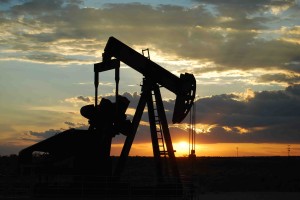redo Jump to...
print Print...
 (by Russell Gold and Daniel Gilbert, The Wall Street Journal) – The U.S. is overtaking Russia as the world’s largest producer of oil and natural gas, a startling shift that is reshaping markets and eroding the clout of traditional energy-rich nations.
(by Russell Gold and Daniel Gilbert, The Wall Street Journal) – The U.S. is overtaking Russia as the world’s largest producer of oil and natural gas, a startling shift that is reshaping markets and eroding the clout of traditional energy-rich nations.
U.S. energy output has been surging in recent years, a comeback fueled by shale-rock formations of oil and natural gas that was unimaginable a decade ago. A Wall Street Journal analysis of global data shows that the U.S. is on track to pass Russia as the world’s largest producer of oil and gas combined this year – if it hasn’t already.
The U.S. ascendance comes as Russia has struggled to maintain its energy output and has yet to embrace technologies such as hydraulic fracturing that have boosted American reserves.
“This is a remarkable turn of events,” said Adam Sieminski , head of the U.S. Energy Information Administration. “This is a new era of thinking about market conditions, and opportunities created by these conditions, that you wouldn’t in a million years have dreamed about.”
The U.S. produced the equivalent of about 22 million barrels a day of oil, natural gas and related fuels in July, according to figures from the EIA and the International Energy Agency. Neither agency has data for Russia’s gas output this year, but Moscow’s forecast for 2013 oil-and-gas production works out to about 21.8 million barrels a day.
U.S. imports of natural gas and crude oil have fallen 32% and 15%, respectively, in the past five years, narrowing the U.S. trade deficit. And since the U.S. is such a big consumer of energy, the shift to producing more of its own oil and gas has left substantial fuel supplies available for other buyers. Nations that rely on peddling petroleum for their economic strength and political clout face dwindling market power as a result. Oil prices so far remain high, however, closing Wednesday at $104.10 a barrel, up 18% from a year ago.
Many analyses of energy markets look only at crude oil. But Russia and the U.S. also are major players in natural-gas markets, where they far outproduce countries such as Saudi Arabia, the world’s largest oil producer.
The U.S. last year tapped more natural gas than Russia for the first time since 1982, according to data from the International Energy Agency (IEA). Russia’s exports have been crimped by rising competition and the economic slump in Europe. Russia forecasts that its gas production will increase slightly in coming years, but its forecast for this year is below current U.S. production.
The U.S. is also catching up in the race to pump crude. Russia produced an average of 10.8 million barrels of oil and related fuel a day in the first half of this year. That was about 900,000 barrels a day more than the U.S. – but down from a gap of three million barrels a day a few years ago, according to the IEA.
The amount of crude from two of the hottest plays in the U.S. – the Bakken oil field in North Dakota and the Eagle Ford shale formation in South Texas – continues to rise rapidly, while Russian output has increased modestly over the past three years. The Russian government predicts oil output will remain flat through 2016, while natural gas ticks up 3%. The shift has raised concerns in Moscow that U.S. crude supplies will crowd out Russia’s oil exports.
“Russia looks like the main loser in the global market,” said Tatiana Mitrova , of the Russian Academy of Sciences’ Energy Research Institute. More than 40% of Russia’s budget comes from oil-and-gas related duties and taxes, she said.
The institute has forecast that Russian oil exports could fall 25% to 30% after 2015, reducing gross domestic product more than $100 billion.
To be sure, Russia is believed to have one of the world’s largest, untapped oil-bearing shale formations, creating the potential for a surge in production. …
Saudi Arabia remains the world’s largest supplier of crude oil and related liquids. As of July, Saudi Arabia was pumping 11.7 million barrels a day, according to the IEA. Russia was second, at 10.8 million barrels, while the U.S. was third, at 10.3 million. Each of the three pumps more than twice the daily output of such major producers as Canada, Venezuela and Nigeria.
Even optimists in the U.S. concede that the shale boom’s longevity could hinge on commodity prices, government regulations and public support, the last of which could be problematic. A poll last month by the Pew Research Center for the People and the Press found that opposition to increased use of fracking rose to 49% from 38% in the previous six months.
Other risk factors: a global economic contraction would depress oil and gas prices, leading companies to slow production. And drilling in shale is expensive and more complex than conventional exploration, leading to concerns that a market downturn could take a large bite out of U.S. output.
—Gregory L. White contributed to this article. [This article was first published at the Wall Street Journal on Oct. 2.]
Copyright 2013 Dow Jones & Company, Inc. All Rights Reserved. Reprinted here for educational purposes only. Visit the website at wsj.com.
Questions
Note to students: Before answering the questions, read the “Background” and “Resources” below.
1. By how much has the U.S. reduced its imports of natural gas and crude oil in the past 5 years?
2. How is the reduction in the amount of foreign gas and oil purchased by the U.S. expected to affect other countries selling gas and oil?
3. What has enabled the U.S. to overtake Russia as the largest producer of natural gas, and possibly do the same with crude oil?
4. The U.S., Russia and Saudi Arabia each produce more than twice as much crude daily as which top 3 oil producing countries?
5. What factors could possibly end the shale boom in the U.S.?
6. This is an important issue for all Americans to understand. It means the difference between affordable, inexpensive fuel/electricity prices, or ever-increasing prices and U.S. dependence on other countries for fuel. President Obama and other liberal Democrats oppose fracking because of environmental concerns. Their main priority is their belief that the environment will be harmed by fracking, as well as the use of any fossil fuels (oil, gas, coal) that heat our homes, power our cars and provide electricity. They support “renewable energy” (solar, wind, water) only. Conservatives and most Republicans say studies show that the use of fracking or the use fossil fuels do not harm our environment, and providing affordable fuel and power for all Americans is the most important; also, that studies show renewable energy can only provide a very small amount of our energy needs. What do you think?
7. Ask a parent to read this article and the information about fracking. Does he/she support fracking in the U.S.? Why or why not?
Background
HYDRAULIC FRACTURING (FRACKING): (from instituteforenergyresearch.org)
- Less than a decade ago, natural gas prices in the U.S. were among the highest in the world.
- However, in the last five years, domestic natural gas reserves have grown 30% due to technological advances in the use of hydraulic fracturing, a drilling method that is coupled with directional drilling to access underground reservoirs of oil and gas.
- This technological breakthrough had an immediate impact on natural gas prices, causing them to plummet and remain low to the present time.
- Despite this important stride toward future U.S. energy security, hydraulic fracturing has come under attack.
- As the newest [focus] of fossil fuel foes, hydraulic fracturing was notably featured in the 2010 movie Gasland, which dramatized the allegation that hydraulic fracturing had been the cause of groundwater contamination.
- Understandably, these reports have caused much public consternation, and have prompted both regulators and legislators to contemplate whether hydraulic fracturing should be subject to additional federal regulation. But are they accurate?
- While the controversy over hydraulic fracturing is new, hydraulic fracturing itself is not. First used in 1947, hydraulic fracturing has been employed in more than a million wells to extract more than 7 billion barrels of oil and 600 trillion feet of natural gas from deep underground shale formations.
- Geologists have long known that shale rock formations contain large amounts of natural gas and oil, but the fossil fuel resources were trapped in layers of rock and could not easily be extracted.
- Two studies conducted by the Environmental Protection Agency (EPA) and the Ground Water Protection Council (GWPC) – the national association of state ground water and underground injection agencies whose mission is to promote the protection and conservation of ground water – found that there have been no confirmed incidents of groundwater contamination from hydraulic fracturing.
- This is particularly noteworthy in consideration of the fact that approximately one million wells have been hydraulically fractured in the United States.
- Furthermore, according to the Interstate Oil and Gas Compact Commission (IOGCC) – the multi-state governmental agency representing states’ oil and gas interests – each IOGCC member state has confirmed that there has not been a case of groundwater contamination where hydraulic fracturing was attributed to be the cause. (read more at instituteforenergyresearch.org/2011/05/03/hydraulic-fracturing-is-it-safe)
NATURAL GAS: (from instituteforenergyresearch.org/energy-overview/natural-gas)
- Natural gas is colorless, odorless fossil fuel gas that is prized for its cleanliness and its many uses – including energy.
- It is produced in much the same way as oil, and in fact is often produced in conjunction with oil.
- The most environmentally-friendly of the fossil fuels, natural gas provides 24% of our total energy supply and approximately 21% of the fuel used to generate electricity.
(read more at instituteforenergyresearch.org/2010/01/20/america-awash-in-natural-gas%E2%80%94as-long-as-hydraulic-fracturing-is-allowed)
From the WSJ article above:
- So far, most companies aren’t dialing back, even though they need access to enormous amounts of capital to pay for the deep wells required to tap dense rock formations.
- Much of the growth in fossil-fuel production comes from companies that need to sell shares, take on debt or sell assets to plug a gap between spending and their revenue. According to an estimate by Barclays, 50 major U.S. oil and gas explorers needed to raise $50.3 billion last year to close that gap.
- Plenty of private-equity funding and overseas investment remains available, industry experts say, and debt remains relatively cheap.
- “The dollars needed have never been larger,” said Maynard Holt , co-president of Houston-based investment bank Tudor, Pickering Holt & Co. “But the money is truly out there. The global energy capital river is flowing our way.”
- U.S. energy producers also are drilling more efficiently and cutting costs in other ways. Some companies have said that the amount of oil and gas produced by shale wells isn’t dropping as fast as predicted.
- Ken Hersh , chief executive of NGP Energy Capital Management LLC, a private-equity fund with $13 billion under management, said the immense amounts of oil and gas uncovered in recent years indicate that the U.S. energy boom could last a long time.
- “It is not a supply question anymore,” he said. “It is about demand and the cost of production. Those are the two drivers.”
Resources
- Read about hydraulic fracturing at:
hydraulicfracturing.com/Process/Pages/information.aspx. - Read about the process for extracting oil from rock (shale) by hydraulic fracturing (fracking) at Chesapeake Energy’s website:
hydraulicfracturing.com/Pages/information.aspx. - Read about energy production in North Dakota:
studentnewsdaily.com/daily-news-article/refineries-sprout-in-north-dakota - Read about the Eagle Ford Shale in Texas:
studentnewsdaily.com/daily-news-article/shale-boom-in-texas-could-increase-u-s-oil-output
Daily “Answers” emails are provided for Daily News Articles, Tuesday’s World Events and Friday’s News Quiz.



